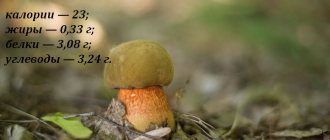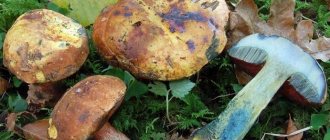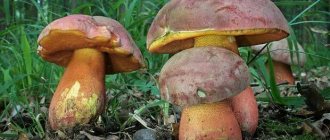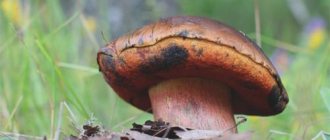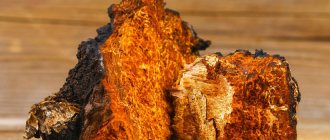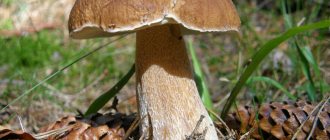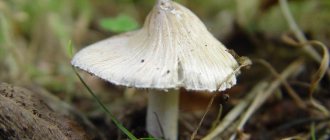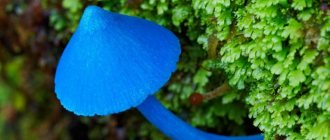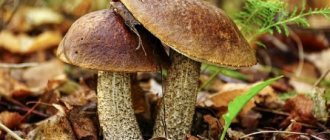In this article we will figure out how to recognize the edible oak tree. Let us list the main differences between a good mushroom and its poisonous counterpart. We will tell you about the peculiarities of preparing and using poddubnik and give several detailed recipes for dishes that include dubovik.
Characteristic
Tubular mushrooms belong to the Boletaceae family. They exude a pleasant and rich aroma and prefer to grow in groups.
Description:
- in adult fruiting bodies the cap is large - about 15 cm in girth;
- its shape is cushion-shaped, the surface is slightly velvety, dry;
- the usual color is brown with an olive tint, some specimens may be reddish, older specimens darken;
- the flesh of the mushrooms is dense, fleshy, in cross section the fruit is white or pale yellow, the inner part of the stem has a scarlet or reddish tone;
- when pressed or broken, the mushroom turns blue, later turning brown;
- The hymenophore tubes are thin, yellowish in young mushrooms, and red-orange in older ones. When pressed, they change color - turn blue;
- pores are bright orange or purple;
- the leg is tall, reddish, red closer to the top, depending on age, reaches 10-15 cm in height, widened at the base.
Edible mushrooms. Types and names of mushrooms with pictures
The best way to independently learn to recognize edible and inedible mushrooms is to familiarize yourself with their names, descriptions and photos. Of course, it is better if you walk through the forest several times with an experienced mushroom picker, or show your catch at home, but everyone needs to learn to distinguish between real and false mushrooms.
You will find the names of mushrooms in alphabetical order, their descriptions and photos in this article, which you can later use as a guide to mushroom growing.
Types and names of mushrooms with pictures
The species diversity of fungi is very wide, so there is a strict classification of these forest inhabitants (Figure 1).
So, according to edibility they are divided into:
- Edible (white, boletus, champignon, chanterelle, etc.);
- Conditionally edible (dubovik, greenfinch, veselka, milk mushroom, line);
- Poisonous (satanic, toadstool, fly agaric).
In addition, they are usually divided according to the type of bottom of the cap. According to this classification, they are tubular (outwardly reminiscent of a porous sponge) and lamellar (plates are clearly visible on the inside of the cap). The first group includes boletus, boletus, boletus and aspen. The second includes saffron milk caps, milk mushrooms, chanterelles, honey mushrooms and russula. Morels are considered a separate group, which includes morels and truffles.
Figure 1. Classification of edible varieties
It is also customary to separate them according to their nutritional value. According to this classification, they are of four types:
- With high taste qualities: saffron milk cap, milk mushroom and white;
- The second category: boletus, boletus, champignons and boletus.
- The third group is the most numerous and includes boletus, chanterelles, trumpets, russula and honey mushrooms.
- The fourth category includes species with the lowest taste: black milk mushrooms, ocher russula, goat and rubella.
Since there are so many types, we will give the names of the most popular ones with their pictures. The best edible mushrooms with photos and names are given in
Edible mushrooms: photos and names
Edible varieties include those that can be freely eaten fresh, dried and boiled. They have high taste qualities, and you can distinguish an edible specimen from an inedible one in the forest by the color and shape of the fruiting body, smell and some characteristic features.
Varieties
The group of oak trees (this is what the name sounds like from the point of view of botanical nomenclature) includes several species. In order not to confuse edible mushrooms with false ones when collecting in the forest, you need to read their description.
Olive brown
This mushroom belongs to the group of conditionally edible ones. The color of the cap served as the basis for the name. Its surface is velvety in young mushrooms. The hemispherical shape very rarely opens up to almost flat. The spongy (tubular) layer is orange-red and turns sharply blue even with slight pressure on it.
The leg is club-shaped, yellow-orange, reddish-brown at the base with a pronounced mesh pattern with elongated loops.
The pulp is yellow, dense, and when broken or in the cut area takes on a blue tone with a pleasant aroma. You can find it in mixed or deciduous forest.
Attention! With the simultaneous use of olive-brown oak and alcohol, problems with the gastrointestinal tract may occur.
Mottled
The speckled pomfret is a conditionally edible variety with a round or cushion-shaped cap of a brown hue. The surface is dry, velvety. The leg is cylindrical or barrel-shaped, red-yellow with small carmine-red scales..
The flesh is yellow and very aromatic when cut.
This species is very reminiscent of olive-brown oak. Even their geographical distribution areas are almost the same. In the European part of the post-Soviet countries, it reaches St. Petersburg, is found in the Caucasus, the south of the Far East and isolated in Eastern Siberia.
Kele
Its fruiting body looks like a slightly flattened egg, since the chestnut cap has a rounded-convex shape. It is smooth and velvety on top. The mushroom is considered inedible, although some reference literature suggests that it is classified as conditionally edible.
The leg is cylindrical, thickened at the base, yellowish-brown, without any patterns or scales on the surface.
The pulp is dense, yellow, quickly turns blue when pressed, and there is no mushroom aroma.
On the territory of Russia it is more common in the Caucasus; it has not been recorded further to the north. Habitats are known in the Far East.
Is the speckled oakberry edible or not?
Speckled Oak (Boletus erythropus) is part of the Boletaceae family. It is considered conditionally edible. It also has other names:
- red-legged boletus;
- bruise;
- boletus;
- granular boletus;
- grain-footed oakwood;
- subdubnik.
Description
The cap of this mushroom is matte, resembles velvet, and may have mucus. Its size ranges from five to twenty centimeters. It is shaped like a pillow or has a more rounded, spherical shape. The cap is dark brown, black-brown, dark brown, sometimes with an olive or red tint. As the mushroom ages, it becomes bare. When its surface is pressed or damaged, this place darkens and takes on a bluish tint.
The inside of the mushroom is yellow. When a mushroom picker cuts it, the cut area almost immediately turns blue or has a greenish tint. The leg has a barrel-shaped or cylindrical shape, and can thicken towards the bottom as the oak tree grows. The inside of the leg is brown or red, there is no taste or smell. On the outside there are reddish scales and specks. Its color is red-yellow, there is no mesh. Dimensions range from five to fifteen centimeters in height, and up to four centimeters in diameter.
If you look under the cap, you can see olive, yellow-green or yellowish tubes. There are also small round pores that are yellow in color and turn reddish or orange as the mushroom ages. They also darken when injured. The spores are brown-olive, their shape is spindle-shaped, and smooth to the touch.
Places where speckled oak grows
Europe, Eastern Siberia, the Caucasus are the places where this mushroom grows. In the western parts of Siberia and the East it is found much less frequently. Just like in Russia.
Likes to settle under trees such as beeches, fir trees, oaks, and firs. Its roots form a symbiosis with the rhizomes of trees. It also grows in marshy soil, along with moss. The choice of place of growth is influenced by its love for acidic soil. New mushrooms appear from May to October.
Is it possible to eat speckled oakberry?
These mushrooms are conditionally edible. To eat them, you need to cook them for about 15 minutes and then pour out the water in which they were boiled. After this, various dishes can be prepared from oak trees, used for side dishes or sauces. After cooking, they practically do not decrease in size. These mushrooms have a lot of aromatic pulp. When fried, dishes turn out very tasty, their beneficial properties are not lost, and they give off a pleasant aroma. In addition, duboviks can be prepared in any form: pickled, dried, salted. Mushrooms for every taste.
Similar mushrooms
These mushrooms, like many others, have many “brothers” similar to themselves. You need to know this and be able to distinguish between them. These include:
- The yellow boletus usually grows in the western part of Europe. It differs from a bruise in its brown-yellow color.
- Kele's Dubovik is rare. Prefers calcareous soils. It differs in the color of the cap: it is lighter and brownish-yellow in color.
- The olive-brown oak tree has a speckled mesh pattern on the stem.
- Satanic mushroom is a poisonous species. In this case, it is especially important not to confuse the mushrooms. It differs from oak wood in its unpleasant odor. In addition, when cut, it does not immediately turn blue; it first turns red.
Useful properties of speckled oak
Dubovik contains useful substances:
- Microelements: copper, zinc, manganese, iron. Copper promotes the formation of blood cells, participates in the body's metabolic processes and the synthesis of pituitary hormones. Zinc improves the functioning of the gastrointestinal tract. Increases the absorption of various nutrients, improves food digestion due to accumulation in the pancreas. Iron is necessary for the formation of hemoglobin, which carries oxygen in the body. A very small portion of mushrooms contains a whole daily dose of microelements.
- Amino acids improve memory, mental abilities, and lead to normal coordination of movements.
- Beta-glucans are beneficial for the immune system and have a negative effect on cancer cells.
In addition, these mushrooms reduce the risk of atherosclerosis.
Eating speckled oakweed!
It must be remembered that mushrooms are conditionally edible and should be consumed with caution. Children under twelve years old should not eat mushrooms. The fact is that they are specific and “heavy” food. They contain chitin, which has a structure intermediate between plant and animal. It is useful for adults, but is not absorbed in the gastrointestinal tract of children.
https://howtogetrid.ru/dubovik-krapchatyj-opisanie-gde-rastet-yadovitost-griba/
Series of messages "Mushrooms: edible, poisonous": Part 1 - Speckled Oak - description of where it grows, the toxicity of the mushroom. Part 2 - Satanic mushroom - description of where it grows, the toxicity of the mushroom Part 3 - Autumn honey fungus - description of where it grows, the toxicity of the mushroom... Part 21 - Rows and what edible mushrooms look like Part 22 - The most beautiful mushrooms: photos, facts, description.
How to distinguish from false
The poddubovik has a false double
The edible mushroom has one poisonous variety - the satanic mushroom. If poisoned, it can have the most unpleasant consequences for human health and life.
Characteristic features that allow you to distinguish the satanic mushroom from real oak mushrooms are:
- Hat: shape: hemispherical or rounded-pillow-shaped; surface: velvety or smooth; Color: from whitish to lead-gray, yellow-pink or greenish stains may occur.
- Pulp: a mature mushroom has an unpleasant odor, reminiscent of rotten onions; for a young mushroom – weak, spicy; at the break it first turns red, and only then turns blue.
- Hymenophore: tube color: yellowish or greenish; pore color: in young mushrooms it is yellowish, but in old ones it is carmine-red or red-brown. When pressed, the damaged area turns blue.
- Leg: the mesh pattern is not elongated, but more or less rounded loops; usually dark red, although there are options - white or dark olive; color: sectoral (top – yellowish-red, middle – carmine-red (orange-red), base – brownish-yellow), but the color transition is very smooth; shape: from spherical to barrel-shaped with a noticeable narrowing at the top.
If, no matter what, the satanic sickness has come to your table, then you should know the first signs of poisoning with this mushroom: nausea and abdominal pain - they appear after 30 minutes or a little more. As soon as you begin to feel them, begin providing first aid to the victim:
- Prepare and give the person to drink 3-4 glasses of a weak solution of potassium permanganate at once and induce vomiting: repeat the “session” at least 5 times.
- Then give a laxative: 1 tbsp. a spoonful of bitter salt (Epsom or Epsom salt, magnesium, magnesium sulfate heptahydrate) per glass of boiled water or 2-3 tbsp. spoons of castor oil (without water!).
- Prepare a glass of hot tea and send the victim to bed.
- Call an ambulance.
But. To prevent this from happening, be careful when picking mushrooms.
Examples
It is difficult for an inexperienced mushroom picker to distinguish these species from edible fruiting bodies. They have no special differences. To recognize them, it is worth studying the descriptions of category representatives.
Autumn oyster mushroom
Fruiting lasts from mid-autumn to mid-winter. The largest harvest is harvested during thaws, when the ambient temperature is 4-6 °C. It grows on deciduous wood: aspen, alder, birch, poplar, and less often on coniferous plants. Occurs in groups.
Worms do not damage autumn oyster mushrooms. Only young mushrooms are used for cooking. They are pre-boiled for 20 minutes. They are used to prepare soups, main courses, and pickles.
Volnushka pink
Rules of use:
- the mushrooms are pre-cooked;
- soak before frying;
- eaten several months after salting.
Black milk mushroom
The second popular name is nigella. Found in birch and mixed forests, near roads. Hides in mosses and leaf litter. Prefers bright places. Forms mycorrhiza with birch. It grows in large groups from early August to November. Mass harvest occurs in mid-August - early September.
Mushrooms are often used salted. Canned milk mushrooms acquire a purple-burgundy color and do not lose their taste for 3 years. To remove bitterness, it is pre-soaked or boiled.
It got its name due to its external resemblance to animal liver. Grows on oaks and chestnuts. Prefers a warm climate, although it is also found in northern regions. The harvest is harvested from the second half of July until frost.
Young specimens are classified as gourmet products. They contain a large amount of acid, which protects the fungus from wood tannins. For this reason, the recipe for their preparation is special:
- they are soaked in salted water from several hours to a day;
- the fluid is changed periodically;
- liverwort preparations are not made.
Where and when does it grow
You can find bobwhites in coniferous, deciduous and mixed forests, in birch groves. Species of dwarf beetles are widespread mainly in Europe, but are less common on other continents.
In nature, this species creates mycosis with various tree species - birch, beech. But the most productive mushroom places are oak groves and forests.
They prefer to grow on calcareous soil where there is access to sunlight. The fruiting period is long - from the beginning of May to the end of October.
In Russia, this mushroom can be found in the European part, in the south and west of Siberia, as well as in the south of the Far East.
Since oak moths are heat-loving species, they are rarely found in the northern zone and regions with unstable weather conditions.
Is the oak mushroom edible or not? Boletus lur />Photo and description of the boletus mushroom
The common dubovik is an edible tubular mushroom, known to most mushroom pickers as the mushroom mushroom.
It grows primarily in small groups from late May to October, producing the most abundant harvests from mid-August to late September. It prefers to settle in open areas of mixed or deciduous forests, as well as along roadsides.
The cap is up to 15 cm in diameter, cushion-shaped, velvety, brown or olive-brown, olive or yellow-brown, to red-brown. The color of the cap can vary greatly; it darkens with age.
The pulp is thick, whitish or yellowish (reddish at the base of the stem), when pressed and when cut, it quickly turns blue, then turns brown. The tubes are narrow, yellow, olive-yellow, the pores are orange-purple, and turn blue when pressed. The leg is 5–15 cm tall, thickened at the base, yellow-orange, with a red-brown mesh pattern at the top.
The fungus forms mycorrhiza with oak, beech, and less often with old birch and other deciduous trees; it grows on calcareous soils, preferring bright, well-warmed places by the sun, in May–October. On the territory of Russia it is found in the European part, in Southern and Western Siberia and in the south of the Far East.
Common oakberry belongs to the second category of mushrooms. It is eaten boiled, fried or dried. In some countries of Western Europe, the mushroom is considered conditionally edible, and in North America it is even poisonous. This is apparently due to the fact that, in combination with alcohol, common oakweed can cause mild food poisoning.
Collection rules
When planning a quiet hunt, you should get a sharp knife, a strong long stick for searching for fruiting bodies in grass thickets and under bushes, as well as a wicker basket.
You need to collect mushrooms carefully, cutting off the stem at the very base. The mycelium (mycelium) remaining in the soil will produce a new harvest in the future. Choose specimens that are not too large; they have increased juiciness, good taste and rich aroma, unlike the old ones.
After collection, the mushrooms are shaken off the ground, freed from other forest debris and placed in a basket.
Growing at home
Growing poultry at home is labor-intensive, but rewarding. To be successful, you need to choose a place near an oak, birch or beech tree where mushrooms grow naturally.
- You should only buy mycelium from trusted suppliers, since the future harvest depends on its quality.
- If you do not have such an opportunity, you can use a few pieces of mycelium brought from the forest.
- Another option is to use 5-6 caps. Wrap them in cloth, place them in a container with water for a day, the next day mash them and put the pulp in a separate bowl.
The top layer of soil 25-30 cm thick is removed from the site and the laying of layers begins in the resulting trench:
- First (lowest layer - 10 cm): fallen leaves, grass, bark from dead wood;
- Second (10 cm): manure humus or soil from under trees. The grain mycelium is scattered on it or watered with water in which the mushroom caps have been infused and the crushed mass of the caps is placed on top.
- Third (3 cm): plant remains, exactly the same as in the first.
- Fourth (3-5 cm): garden soil.
The last stage is light irrigation with warm water. To avoid drying out and increase the success of germination, the soil is covered with a layer of pine sawdust or wood chips.
Under favorable conditions, young fruiting bodies will appear in this place next year.
Poddubnik mushroom is one of the most delicious universal species, which is widely used in medicine and cooking. If you follow all the rules of collection and preparation, such a product will become a real delicacy on your table and will bring great benefits to the whole family.
Beneficial features
The beneficial properties of this mushroom are due to its rich and varied composition. The pulp contains vitamins A, C, B1 and B2, dietary fiber, fats, proteins, nutrients and trace elements. Therefore, eating such mushrooms is beneficial for the whole body.
Fiber promotes high-quality intestinal cleansing (works like a natural broom), normalizes metabolic processes and lowers blood sugar levels.
Doctors note the benefits of the product for those who want to lose weight, since 100 g contains only 34 kcal.
With regular consumption of fruiting bodies, hemoglobin increases and hormonal levels stabilize.
When boiled, mushrooms help compensate for the lack of zinc, magnesium and copper.
Contraindications
Mushrooms should not be eaten raw
The trumpet mushroom is considered an edible mushroom, but it is prohibited to eat it raw.
Undercooked mushrooms can also cause great harm to health (incomplete heat treatment of any food is dangerous) - indigestion, diarrhea, abdominal pain, nausea and vomiting. Against this background, severe intoxication of the body can develop, which only a doctor can eliminate.
They should not be eaten by women during pregnancy and lactation, children under 12 years of age, or if they have an individual intolerance to the product.
There are also contraindications for people with serious stomach and intestinal problems.
Cooking
Thanks to its beneficial composition and excellent taste, this product is widely used in various areas of production.
There are a wide variety of methods for preparing subdubnik. But before preparing any dish, the fruiting bodies are boiled, since they are recognized as conditionally edible.
First, the mushrooms are washed twice in clean water. Then cut into pieces of the required size, transfer to a saucepan, add water, and add a little salt. You need to cook for 15 minutes, then boil again for the same amount of time. At each stage the water is changed.
Soup with subdubniks
Required components:
- carrots and onions - 1 pc.;
- potatoes - 3-4 pcs.;
- boiled whole mushrooms - 5-6 pcs.;
- vegetable oil - 1-2 tbsp. l.;
- salt, spices - to taste.
The fruiting bodies are crushed into pieces, then transferred to a saucepan, filled with water, and simmered over low heat, remembering to periodically remove the foam. After this, salt and pepper to taste.
While the mushrooms are cooking, you can peel the onion, finely chop it, grate the carrots on a coarse grater, and fry it all in vegetable oil until golden brown.
Cut the potatoes into cubes and add them to the mushrooms along with the frying. Cook until the potatoes are fully cooked.
It is advisable to serve this soup with sour cream and chopped herbs (dill, parsley).
Marinated podduboviki
Podduboviki are delicious when marinated.
For pickling you need 1 kg of pre-boiled fruit bodies. Place them in a saucepan with water, add some salt, and cook for 15 minutes.
Then the broth is drained, poured again with clean water, a little salt, a couple of black peppercorns and a bay leaf are added, and boiled for the same amount of time.
Next, you need to prepare the marinade to your taste from water, salt, sugar and spices. Add 1-2 tbsp to it. vinegar and 2 pinches of citric acid (if your recipe does not include citric acid, do not add).
Advice. When marinating, rely on your marinade recipe, and additional ingredients can be found on the Internet or in a cookbook.
Place the mushrooms in a colander, and when the liquid has drained, place them in a saucepan, pour over the marinade, boil for 5 minutes and transfer to a jar, pour over the remaining brine after cooking, pour vinegar on top, close the lid tightly and take it to the basement for storage or put it in the refrigerator.
Solyanka mushroom
To prepare this dish you will need:
The preparation of this dish consists of several stages.
- Pre-boiled mushrooms must be cut into small pieces.
- Fry sliced mushrooms along with finely chopped onion in vegetable oil.
- After 10 minutes of frying, add the pickled cucumber cubes.
- Chop half the cabbage and simmer in a casserole over low heat for about 30 minutes. Add sugar, tomato paste and spices to taste.
- Combine the cabbage with the roast in one bowl, add a little water, and place in the oven to bake at 180°C for 10-15 minutes.
The finished dish is served with sour cream and finely chopped herbs.
For your information. To enhance the taste, you can add a little sauerkraut to the dish. In this case, so that the hodgepodge does not turn out sour, you cannot put pickled or salted mushrooms in it. For these purposes, fresh or boiled are better suited.
Mushroom paste
To prepare the aromatic paste you will need several ingredients:
- boiled mushrooms - 200 g;
- grated hard cheese - 200 g;
- low-fat cottage cheese - 100 g;
- chopped walnuts - 2 tbsp. l.;
- mushroom broth - 10 tbsp. l.;
- finely chopped dill or parsley - 2 tbsp. l.;
- vegetable oil - 1-2 tbsp. l.;
- salt, pepper - to taste;
- parsley - for decoration.
Fry the boiled mushrooms in vegetable oil until golden brown, and after cooling, grind in a blender. Mix the cottage cheese, pureed through a sieve, with grated cheese, add to the mushrooms, salt and pepper. Add walnuts and sprinkle it all with herbs. Blend again with a blender until smooth.
Spread the resulting mushroom sauce over the pasta. Before serving, garnish with parsley.
Application
In cooking
Dubovik has excellent taste and aromatic qualities, so it is not at all surprising that this mushroom is actively used in cooking. Due to the fact that the butterfly is recognized as conditionally edible, it is necessary to carry out some actions so that it can be eaten and delicious dishes can be created based on it.
- The collected mushrooms must be poured with running cold water and left in this form for at least 12 hours. During this time, change the water to clean water every 2 hours.
- After the specified period, we thoroughly wash the oak wood, removing dirt and damaged areas.
- After this, put the clean mushrooms in a saucepan and cook them over medium heat for 1 hour. During the cooking process, the toxins that are part of this type of mushroom are destroyed. And even after heat treatment, the poddubnik retains its beneficial properties, smells great and has a unique, wonderful taste.
- We filter the boiled mushrooms and can cook them according to any recipe you like.
Important! If you ignore the soaking and decoction of the butternut squash, then eating dishes containing it can lead to problems with the gastrointestinal tract.
- Poddubnik is excellent for pickling, and if you add a little citric acid to it, then the mushroom does not lose its rich color even after long-term storage.
- After heat treatment, the mushrooms can be fried and then served with your favorite sauce.
- Using dubovik, you can prepare amazing soups, unforgettable sauces, and delicious dressings in addition to any side dish.
In medicine
In folk medicine, poddubnik is known as an effective medicine, primarily against malignant tumors.
Our distant ancestors discovered the miraculous properties of this mushroom - balms and lotions were made on their basis, when applied:
- fatigue disappeared;
- the depression disappeared;
- fatigue decreased;
- nerves calmed down.
Medicine
The pulp of fresh tubular mushroom contains the substance boletol (biological pigment), which is a kind of antibiotic - it destroys all pathogenic microbes and bacteria in the body.
When consumed regularly, this product improves immunity, prevents the development of cancer and promotes the effective treatment of malignant tumors.
The amino acids included in the composition prevent the appearance of atherosclerosis, improve memory and brain activity.
In the old days, tinctures and balms were prepared from fruiting bodies to eliminate problems with the central nervous system, to increase tone when there was a loss of strength.
Dishes prepared with the addition of poultry help to normalize digestion and replenish the lack of vitamins and minerals in the body.
